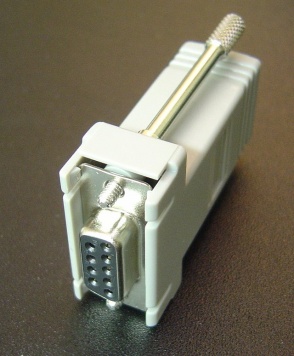Difference between revisions of "Cable Spec 1"
From ATTWiki
(→Straight Through Pinout) |
|||
| Line 101: | Line 101: | ||
<br> | <br> | ||
<br> | <br> | ||
| + | ==Note about the DCD Yellow Wire== | ||
The DCD Yellow (RJ45 Pin 6) connection was added on July 4, 2014. It is necessary for a connection to connector cable spec 40 for connection to the MiiC benders. (See [[Cable Spec 40 - RJ45-DB25 MiiC Pinout]]) | The DCD Yellow (RJ45 Pin 6) connection was added on July 4, 2014. It is necessary for a connection to connector cable spec 40 for connection to the MiiC benders. (See [[Cable Spec 40 - RJ45-DB25 MiiC Pinout]]) | ||
'''Please be sure to include the DCD Yellow wire in all Cable Spec 1 adapters so that we can assume that they will work with MiiC benders.''' | '''Please be sure to include the DCD Yellow wire in all Cable Spec 1 adapters so that we can assume that they will work with MiiC benders.''' | ||
Revision as of 16:59, 9 December 2017
Contents |
Spec for RJ-45 to DB-9 Female Adapter - "ST" or Straight Through
This is the original RJ-45 to DB-9 conversion spec. It is good for all applications except Benderlink Ethernet Modules with the CB-EL1 current loop board.
Use DB-9 FEMALE for connection to standard male COM ports.
Straight Through Pinout
| RJ-45 Side - Female | DB9 Side - Female |
| Function | Wire Color |
RJ-45 Pin |
to | DB9 Pin |
Function |
| RTS | Blue | 1 | ---- | 7 | RTS |
| DTR | Orange | 2 | ---- | 4 | DTR (+5v) |
| GND | Black | 3 | ---- | 5 | GND |
| TXD | Red | 4 | ---- | 3 | TXD |
| RXD | Green | 5 | ---- | 2 | RXD |
| DCD | Yellow | 6 | ---- | 1 | DCD |
| DSR | Brown | 7 | ---- | 6 | DSR |
| CTS | Grey | 8 | ---- | 8 | CTS |
Note about the DCD Yellow Wire
The DCD Yellow (RJ45 Pin 6) connection was added on July 4, 2014. It is necessary for a connection to connector cable spec 40 for connection to the MiiC benders. (See Cable Spec 40 - RJ45-DB25 MiiC Pinout) Please be sure to include the DCD Yellow wire in all Cable Spec 1 adapters so that we can assume that they will work with MiiC benders.
Label
Lable each of these adapters with "ST", which means "Straight Through".
Important Testing Note
| The receiving pins in this adapter are prone to jump out of their inserted holes if they are not properly pressed in. With the plug NOT snapped into the cover, plug the port into a DB9 male port to be sure none of the receiving pins are pressed back out of the inserted holes. |
